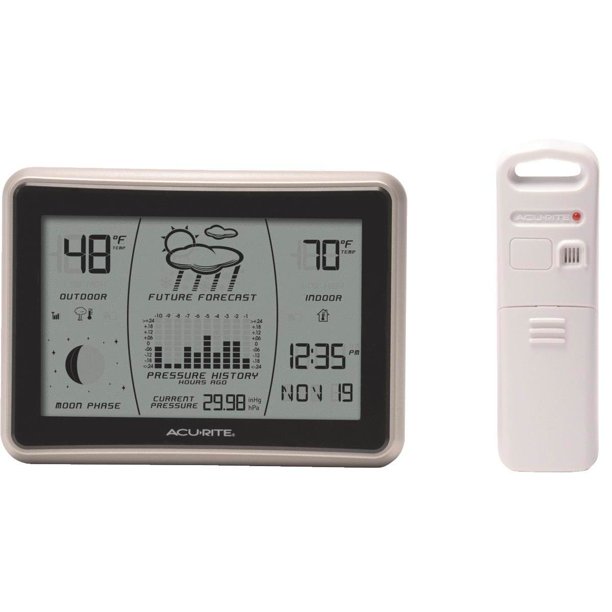Instruction Manual
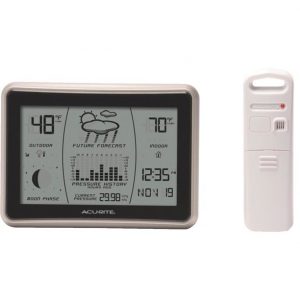
ACURITE Wireless Weather Station with Barometric Pressure Charging
Package Contents:

- ( 1 ) Main Unit (A) with stand
- ( 1) Wireless Sensor [Bl
- ( 1 I Instruction Manual
What You Need:
- Small Phillips Screwdriver
- (5) AA batteries see “Install Batteries”(pg.2)
Thank You for purchasing this ACURITE® product. Please read this manual in it’sentirety to fully enjoy the benefits and features of this product. Please keep this manual for future reference.
NOTE: A clear film is applied to the LCD at the factory that must be removed prior to using this product. Locate the clear tab and simply peel to remove.
OVERVIEW OF FEATURES
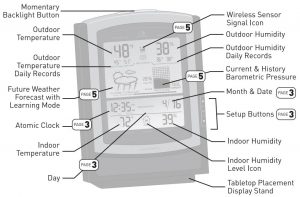
SETUP
Battery Choice & Temperature Range
Extended periods of cold temperatures I below -4°F / -20°C I can cause alkaline batteries to function improperly. This will cause the outdoor wireless sensor to stop transmitting temperature readings. Use lithium batteries in these low temperature conditions to ensure continued operation for wireless sensors placed outdoors. NOTE: Rechargeable batteries are not recommended due to higher operating voltages.

Install BatteriesNOTE: Install all batteries in both units within a 6 minute period to ensure proper wireless functionality. Always install batteries into the wireless sensor FIRST.
A. Wireless SensorRemove the 4 battery compartment screws and cover utilizing a small Phillips type screwdriver. Install 2 fresh “AA” batteries as shown here.
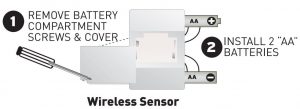
B. Main UnitRemove the battery compartment cover and install 3 fresh “AA” batteries as shown here.
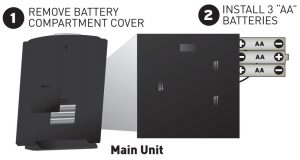
A/B/C Wireless SelectionTo allow for more than one weather station and wireless sensor network to be used in close proximity, the main unit and the wireless sensor have a small switch labeled “A B C” within the battery compartments. This switch selects one of 3 wireless modes to use, and both switches MUST be set in matching positions (either A, B, or C) for wireless communication to take place successfully
About the Atomic Clock
A clock is considered atomic if it has an accuracy of one second in a million years. Consumer clocks are considered atomic if they attain this accuracy by receiving a signal from an atomic clock. In North America, the National Institute of Standards and Technologies operates an atomic clock in Colorado which transmits the time codes via the radio station WWVB. The Acurite clock you have purchased includes a built-in receiver which picks up the signal from the WWVB station. For the best possible reception, place the main unit with the back side facing Colorado. NOTE: Due to solar radiation in the atmosphere, the atomic clock signal is weaker during the day. Most synchronization with the WWVB atomic clock signal happens at night when there is less interference.
Main Unit : Basic Setup
After installing batteries, it is recommended that you set the clock and calendar initially. After the atomic clock signal is acquired, which may take up to 24 hours, the clock accuracy and daylight saving time changes will be automatically maintained.
To set the clock and other preferences, press the “SET” button to enter into SET MODE. Once in set mode, the preference you are currently setting will blink on the display.
To adjust the currently selected (flashing) preference item, press the ▲.or ▼ buttons (press and HOLD to fast adjust).
To save your adjustments, press the “SET” button again to move on to adjusting the next preference. The preference set order is as follows:
TIME ZONE (PST MST CST EST)DST(Daylight Saving Time ON OR OFF)CLOCK HOURCLOCK MINUTECALENDAR DATECALENDAR M ONTHCALENDAR YEARTEMPERATURE SCALE(°For °C)BAROMETRIC PRESSURES CALE( in Hg or hPa)
You will automatically exit SET MODE if no buttons are depressed for :30 seconds. You may enter basic setup mode again at any time by pressing the “SET” button.
Basic Setup is Now CompleteThe wireless sensor will soon send a signal to the main unit and the two units will be synchronized. It may take a few minutes for synchronization to be complete. If both or one of the units appear to be functioning improperly, refer to the troubleshooting section in this manual.
PLACEMENT
Now that setup is complete, you must choose a location to place the wireless sensor and the main unit. The wireless sensor MUST be placed less than 100 feet (30 meters] away from the main unit.
This wireless thermometer uses radio frequency for communication, which is susceptible to interference from other electronic devices and large metallic items or thick walls. Always place both units at least 3 feet 1.91 ml away from appliances I TV, microwave, radios, etc. I or objects that may interfere with the wireless communication I large metal surfaces, thick stone walls, etc. ]

Placement of Main UnitPlace the main unit in a dry area free of dirt and dust. To help ensure an accurate indoor temperature measurement, be sure to place the main unit out of direct sunlight, and away from any heat sources or vents in your home. For the best atomic clock signal reception, place the main unit with the back side facing the state of Colorado.
There are 2 placement options for the main unit. You may hang the main unit on a wall using the integrated hang hole. Alternatively, you may place the main unit on a table top or other flat surface using the included detachable table top display stand.
Placement of SensorThe wireless sensor MUST BE PLACED OUTDOORS to observe outdoor temperatures/humidity and relay the outdoor temperature/humidity to the main unit display. The wireless sensor must be placed less than 100feet (30 ml from the main unit.
The wireless sensor is water resistant and is designed for outdoor use. However, to extend the life of the product, place the wireless sensor in an area protected from direct weather elements. To ensure an accurate outdoor temperature measurement, be sure the wireless sensor is placed out of direct sunlight and away from any heat sources. Additionally, to prevent inaccurate humidity readings, do not place the sensor near any water or moisture sources.
OPERATION
After the main unit and the wireless sensor are both powered on and wireless synchronized, no further input is required. The atomic clock will automatically re-synchronize occasionally to ensure the clock is accurate (provided the atomic clock signal is acquired).
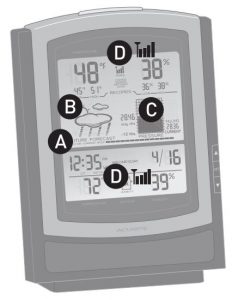
(A) 14 Day Learning ModeThis weather station has a patented “fourteen day learning mode” calibration process. During this learning mode the weather station will make altitude calculations that may affect the accuracy of the forecast. Once the 14 day learning mode process is complete, the learning mode icon will disappear and the weather forecast should be ready for superior operation.
(B) Forecast IconThis feature gives you the predicted weather forecast for the next 12 to 24 hours based on an advanced algorithm that includes barometric pressure and temperature. This weather station will provide the most accurate forecast that a single station weather instrument can provide.
(C) Barometric Pressure: Current and History
This weather station has a pressure graph that tracks and displays the barometric pressure 12 hours ago as well as the current barometric pressure. Additionally, the graph will automatically display the “FALLING”, “STEADY” or “RISING” icon and a curve to represent the rate of change over previous 12 hour time period.
(D) Wireless Signal Reception IconsThe main unit has signal reception icons in the outdoor temperature display area and near the atomic clock display. If there are a low number of “bars” present, you may experience no temperature display “__” or inaccuracy. In either case, you may need to relocate one or both of the units. If most or all 4 of the bars are present, wireless reception is good and no action is required. If the atomic clock signal bars are low, the clock may be inaccurate or may not automatically adjust for daylight saving time (DST].
Troubleshooting
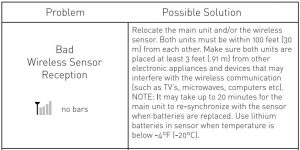
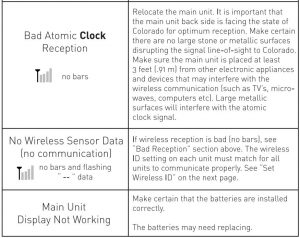
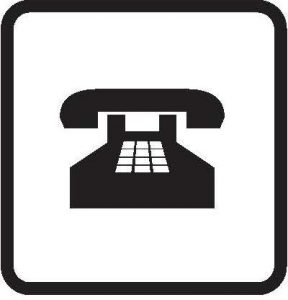 Please DO NOT return product to the retail store.For technical assistance and product return information, please callCustomer Care: 877-221-1252 Mon. – Fri. 8:00 A.M. to 4:45 P.M. [CST)
Please DO NOT return product to the retail store.For technical assistance and product return information, please callCustomer Care: 877-221-1252 Mon. – Fri. 8:00 A.M. to 4:45 P.M. [CST)
Imported by:Costco Wholesale Corporation P.O. Box 34535Seattle, WA 98124-1535U.S.A.1-800-77 4-2678Shop at www.costco.com
Set Wireless ID
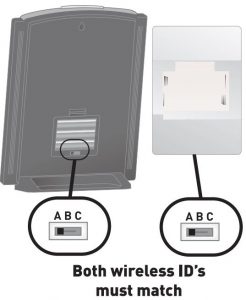
This wireless thermometer uses long range 433mhz radio frequency for communication.
In the event that you have reception problems due to interference, both the main unit and the wireless sensor have a selectable wireless ID. The ID switches are located within the battery compartments of the main unit and the wireless sensor.
You may choose A, B or C; but both the main unit and the wireless sensor ID’s must match for successful synchronization.
PRODUCT SPECIFICATIONS
Measurement RangesTemperature
Main Unit: 32°F to 122°F I o0c to 50°CWireless Sensor: -40°F to 158°F I -40°C to 70°C
SpecificationsPower Requirements
Main Unit: 3 x “M’ alkaline or lithium batteries Wireless Sensor: 2 x “M’ alkaline or lithium batteries
Atomic Clock Frequency: WWVB 60Khz Synchronizes Daily
Wireless Communication 433 mhz Radio Frequency-Transmission every 16 seconds
PLEASE DISPOSE OF OLD OR DEFECTIVE BATTERIES IN AN ENVIRONMENTALLY SAFE WAY AND IN ACCORDANCE WITH YOUR LOCAL LAWS AND REGULATIONS. BATIE RY SAFETY: Clean the battery contacts and also those of the device prior to battery installation. Remove batteries from equipment which is not to be used for an extended period of time. Follow the polarity!+/-) diagram in the battery compartment. Promptly remove dead batteries from the device. Dispose of used batteries properly. Only batteries of the same or equivalent type as recommended are to be used. DO NOT incinerate used batteries. DO NOT dispose of batteries in fire, as batteries may explode or leak. DO NOT mix old and new batteries or types of batteries (alkaline/standard). DO NOT use rechargeable batteries. DO NOT recharge non-rechargeable batteries. DO NOT short-circuit the supply terminals.
To receive product information, register your product online. Ifs quick and easy!Log on to http://www.chaneyinstrument.com/product_reg.htm
LIMITED ONE YEAR WARRANTY
Chaney Instrument Company warrants that all products it manufactures to be of good material and workmanship and to be free of defects if properly installed and operated for a period of one year from date of purchase. REMEDY FOR BREACH OF THIS WARRANTY IS EXPRESSLY LIMITED TO REPAIR OR REPLACEMENT OF DEFECTIVE ITEMS. Any product which, under normal use and service, is proven 1o breach the warranty contained herein within ONE YEAR from date of sale will, upon examination by Chaney, and a1 its sole option, be repaired or replaced by Chaney. In all cases, transportation cos1s and charges for returned goods shall be paid for by the purchaser. Chaney hereby disclaims all responsibility for such transportation cos1s and charges. This warranty will not be breached, and Chaney will give no credit for products it manufactures which shall have received normal wear and tear, been damaged, tampered, abused, improperly installed, damaged in shipping, or repaired or altered by others than authorized representatives of Chaney.
THE ABOVE-DESCRIBED WARRANTY IS EXPRESSLY IN LIEU OF ALL OTHER WARRANTIES, EXPRESS OR IMPLIED, AND ALL OTHER WARRANTIES ARE HEREBY EXPRESSLY DISCLAIMED, INCWDI NG WITHOUT LIMITATION THE IMPLIED WARRANTY OF MERCHANTABILITY AND THE IMPLIED WARRANTY OF FITNESS FOR A PARTICULAR PURPOSE. CHANEY EXPRESSLY DISCLAIMS ALL LIABILITY FOR SPECIAL, CONSEQUENTIAL OR INCIDENTAL DAMAGES, WHETHER ARISING IN TORT OR BY CONTRACT FROM ANY BREACH OF TH IS WARRANTY SOME STATES DO NOT ALL.OW THE EXCLUSION OR LIMITATION OF INCIDENTAL OR CONSEQUENTIAL DAMAGES, SO THE ABOVE LIMITATION OR EXCLUSION MAY NOT APPLY TO YOU. CHANEY FURTHER DISCLAIMS ALL LIABILITY FROM PERSONAL INJURY RELATING TO ITS PRODUCTS TO THE EXTENT PERMITTED BY LAW. BY ACCEPTANCE OF ANY OF CHANEY’S EQUIPMENT OR PRODUCTS, THE PURCHASER ASSUMES ALL LIABILITY FOR THE CONSEQUENCES ARISING FROM THEIR USE OR MISUSE. NO PERSON, FIRM OR CORPORATION IS AUTHORIZED TO ASSUME FOR CHANEY ANY OTHER LIABILITY IN CONNECTION WITH THE SALE OF ITS PRODUCTS. FURTHERMORE, NO PERSON, FIRM OR CORPORATION IS AUTHORIZED TO MODIFY OR WAIVE THE TERMS OF THIS PARAGRAPH, AND THE PRECEDING PARAGRAPH, UNLESS DONE IN WRITING AND SIGNED BY A DULY AUTHORIZED AGENT OF CHANEY. THIS WARRANTY GIVES YOU SPECIFIC LEGAL RIGHTS, AND YOU MAY ALSO HAVE OTHER RIGHTS WHICH VARY FROM STATE TO STATE.
For in-warranty repair, please contact: Customer Care DepartmentChaney Instrument Company965 Wells StreetLake Geneva, WI 53147
Chaney Customer Care877·221·1252Mon-Fri 8.00 a.m. to 4.45 p.m. CSTwww.chaneyinstrument.com
![]() This device complies with part 15 of the FCC rules. Operation is subject to the following_ two conditions:
This device complies with part 15 of the FCC rules. Operation is subject to the following_ two conditions:
- This device may NOT cause harmful interference, and
- This device must accept any interference received, including interference that may cause undesired operation.
NOTE: This equipment has been tested and found to comply with the limits for a Class 8 digital device, pursuant to Part 15 of the FCC rules. These limits are designed to provide reasonable protection against harmful interference in a residential installation. This equipment generates, uses and can radiate radio frequency energy and, if not installed and used in accordance with the instructions, may cause harmful interference to radio communications.However, There is no guarantee that interference will not occur in a particular installation. If thisequipment does cause harmful interference to radio or television reception, which can be determined by turning the equipment off and on, the user is encouraged to try to correct the interference by one or more of the following measures:
- Reorient or relocate the receiving antenna.
- Increase the separation between the equipment and the receiver.
- Connect the equipment into an outlet on a circuit different from that to which the receiver is connected.
- Consult the dealer or an experienced radio TV technician for help.
NOTE: The manufacturer is not responsible for any radio or TV interference caused by unauthorized modifications to this equipment. Such modifications could void the user authority to operate the equipment.
Patent numbers: 5,978,738; 6,076,044; 6,597,990
ACURITE Wireless Weather Station with Barometric Pressure Charging Instruction Manual – ACURITE Wireless Weather Station with Barometric Pressure Charging Instruction Manual –
Questions about your Manual? Post in the comments!
References
[xyz-ips snippet=”download-snippet”]

